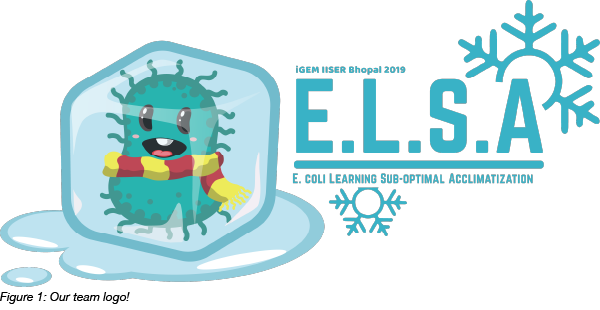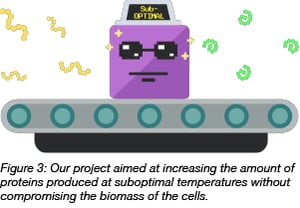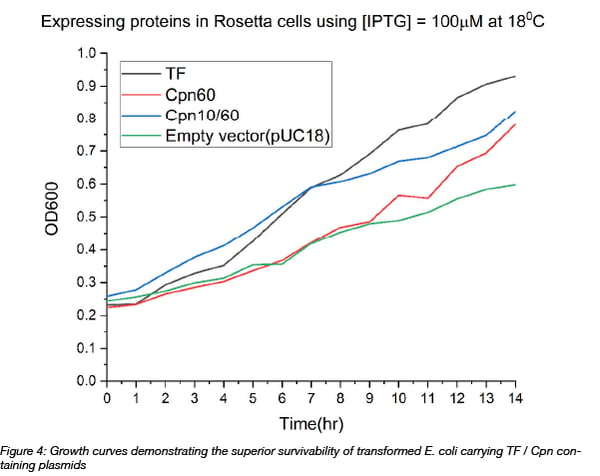This post was contributed by Sreepadmanabh M, a member of the iGEM team from IISER Bhopal.
Following up its 2018 iGEM debut - centered around a prototypical methane biosensor - IISER Bhopal is back in the SynBio arena this year with a fresh team of twenty excited undergrads. Team IISER-B’s idea for the iGEM 2019 is to take bacteria out of their optimally suited temperature ranges and make them grow better at suboptimal ones, which could allow even your regular E. coli to thrive in the bitter cold.

Since our objective is to induce tolerance towards cold, we decided to focus on a special class of enzymes expressed by psychrophilic (cold-loving) bacteria. These bacteria inhabit cold temperature locales and psychrophilic enzymes help them survive under severely cold conditions. To understand their unique importance, let’s begin with a few basics.
Mesophiles vs. extremophiles
Mesophilic organisms are your regular next-door microbes which grow optimally in moderate temperatures (usually defined between a fairly nippy 20°C to a decidedly uncomfortable 45°C). Their more adventurous cousins are the extremophiles - the legends who not only survive, but thrive, in the face of some of Earth’s harshest environments: corrosive pH ranges, crushing pressures, near-melting temperatures, tons of radiation, or freezing cold conditions. However, many of the detailed mechanisms that allow extremophiles to survive under these conditions are currently unknown, and it’ll undoubtedly be quite a while before we can firmly gain a handle on understanding and appreciating their biology.
The importance of psychrophilic enzymes
From an industrial perspective, the enzymes obtained from psychrophiles can be used for a diverse array of processes. The food processing industry, for instance, employs psychrophilic enzymes for milk processing, fruit juice clarification, meat tendering, and oligosaccharide synthesis. A major incentive to use cold-active psychrophilic enzymes is the fact that raw materials degrade at a much slower rate under cold temperatures, and frigid conditions decrease the potential for microbial contamination. Additionally, the high activity of these enzymes implies that even a minute quantity can significantly reduce the operational time for a given process. These are extremely useful benefits for any food processing industry as it can potentially help minimize the incidental losses like spoilage and improve the productive efficiency.

Finding recombinant psychrophilic enzymes for the host
The expression of recombinant proteins for industrial or research purposes requires stable host cells (the simplest example would be a transformed mesophilic, for example E. coli, carrying a plasmid expressing a protein of interest). Mesophilic microbes are highly preferable (and successful) as host systems since their biology is well studied, and they are convenient to maintain under standard conditions. However, one of the many proteins which are not compatible with regular mesophilic systems are the psychrophilic enzymes.

The reason behind this isn’t really hard to guess. Think about it like winter tires in different conditions: the more flexible rubber of winter tires give a better grip in the cold, but wear out rapidly in warm weather. Psychrophilic enzymes face very similar issues when forced to express in mesophilic host systems. The so-called “regular” temperatures of growth, say around 37°C, is a far cry from their native conditions of ~0°C, which drastically affects their stable folding and efficient functioning. But what about placing the mesophilic hosts at 0°C? That won’t work out either - most mesophilic systems would either die out or grow so inefficiently that no industrial operation would ever consider them worth the trouble.
Enter ELSA: E. coli Learning Suboptimal Acclimatisation
To resolve this impasse, our team decided to create a hybrid system where we could incorporate cold-tolerance inducing genes within a regular mesophilic host system. This would make the host able to grow at low temperatures suitable for the expression of psychrophilic proteins. The primary problem we wanted to overcome was inefficient protein folding at low temperatures, since mesophilic chaperones would not function well under suboptimal conditions. This means recombinant proteins can aggregate or precipitate out as insoluble granules.
We overcame this problem by engineering a plasmid which contained cold tolerant chaperones (the Cpn 10/60 isolated from Oleispira antarctica, and the P. haloplanktis Trigger Factor), that would allow the stable folding and expression of recombinant psychrophilic proteins. As the figure below shows, E. coli expressing the chaperones protein resulted in higher levels of growth compared to the E. coli strain expressing the empty vector. And thus was born ELSA - our happy lil’ cold-tolerant E. coli! Additionally, we’re also working towards widening the applicability of our strategy using the pMBP-LbCas12a and pC013-Twinstrep-SUMO-huLwCas13a plasmids from Addgene, which would potentially allow a stable Cas expression under low temperature conditions, thereby enabling efficient CRISPR-Cas mediated editing for psychrophilic systems as well as engineering and regulating psychrophilic recombinant proteins.

To infinity, and beyond!
Keeping in spirit with iGEM’s emphasis on holistic, community-centric science, our team has continuously engaged with a variety of stakeholders from industrial and commercial operators, government agencies, active researchers, as well as fellow iGEM teams. We were the proud hosts for the 2019 All-India iGEM Meet-up, which served as a platform for all the Indian iGEM teams to interact with personnel from the industry and brainstorm with each other. The event also featured a seminar on “Tools to increase scientific reproducibility” by Benoit Giquel, an outreach scientist from Addgene. The talk highlighted the importance of reagent repositories and the myriad facilities offered by them which help foster a more productive and collaborative environment for research.
We’ve also involved ourselves in extensive outreach programs to encourage and embolden the spirit of scientific innovation amongst school children through summer workshops and interactive discussions. Not only are such endeavors a welcome changeover from conventional academic settings, these are an eye-opening experience for cultivating a nuanced understanding of the societal ramifications of laboratory science, and how it may best be leveraged for harmonious progress.
We’re always delighted to engage with potential collaborators and interested audiences. Please visit our team wiki or contact us at igemiiserb@gmail.com.
Many thanks to our guest blogger Sreepadmanabh M from IISER Bhopal. All illustrations / figures featured were designed by our team member Kallol Mozumdar.
 Sreepadmanabh M is a member of the team from IISER Bhopal which received the Silver Medal in the Undergrad category at the iGEM Competition 2019. He has an active interest in scientific writing and science communication, and is a fledgling (though infrequent) blogger.
Sreepadmanabh M is a member of the team from IISER Bhopal which received the Silver Medal in the Undergrad category at the iGEM Competition 2019. He has an active interest in scientific writing and science communication, and is a fledgling (though infrequent) blogger.
Additional resources on the Addgene blog
- Find our synthetic biology blog posts
Resources on Addgene.org
- Find plasmids for your synthetic biology experiment
- Read our Genome Engineering Guide
Topics: Synthetic Biology, Other





Leave a Comment